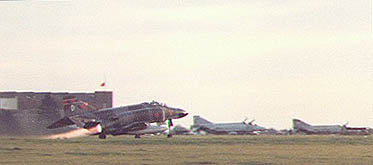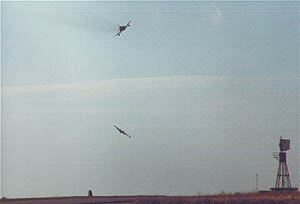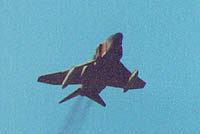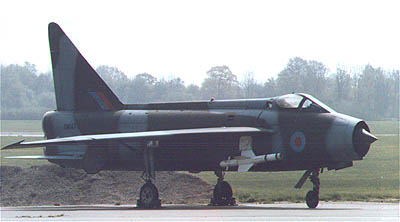![]()
Spotlight: "Red, Red, Red, Air Attack Red!"… by Tom McGhee
 ...the call came blaring over the tannoy system and
yet again personnel dived for their S10 respirators and helmets before
scampering to their designated air raid shelters. Seconds after getting
under cover the roar overhead indicates that another incoming raid has
got through the multi-layered defences and was wreaking havoc somewhere
on the airfield. Hopefully the old decoy aircraft scattered around the
airfield were taking the brunt of the hits, rather than the operational
Phantoms of 23 and 56 Squadrons. These repeated attacks were getting tiring
for the personnel involved, but not so for us watching from outside the
fence as RAF Wattisham was once again the number one target in Exercise
Priory.
...the call came blaring over the tannoy system and
yet again personnel dived for their S10 respirators and helmets before
scampering to their designated air raid shelters. Seconds after getting
under cover the roar overhead indicates that another incoming raid has
got through the multi-layered defences and was wreaking havoc somewhere
on the airfield. Hopefully the old decoy aircraft scattered around the
airfield were taking the brunt of the hits, rather than the operational
Phantoms of 23 and 56 Squadrons. These repeated attacks were getting tiring
for the personnel involved, but not so for us watching from outside the
fence as RAF Wattisham was once again the number one target in Exercise
Priory.
The Priory series of Exercises were held regularly during the 1980s and along with Mallet Blow, Elder Forest, and other associated exercises put UK Air Defences fully to the test. The format of the exercises usually involved a Monday to gather all the assets together, Tuesday, Wednesday, and Thursday of intense air activity, and a Friday wash-up day. All of the UK Air Defences would be tested, and to simulate the full wrath of a Warsaw Pact attack, aircraft from numerous NATO nations would fly realistic attack missions against Britain’s East coast. From the Bloodhound Air Defence unit at RAF Bawdsey in Suffolk, all the way up to the Phantom Fighter base at RAF Leuchars in Fife, all of 11 Group’s units would be subject to the week-long training exercise.
A typical Priory
week would see the best concentration of fighter aircraft available anywhere
in Europe, here’s a typical rundown of  what additional aircraft
would be around:
what additional aircraft
would be around:
| Wattisham | 12 Hawk T1A Point Defence Fighters |
| Honington | 6 RAFG Tornado GR1s, 4 x Dutch AF F16s |
| Coltishall | 12 French AF Jaguars, 6 Danish AF F16s |
| Marham | 2 French Mirage F1CRs |
| Wyton | 3 Italian AF Piaggio PD808s, 2 German AF HansaJets, 1 Norwegian AF Falcon |
| Cottesmore | 12 German AF AlphaJets |
| Waddington | 12 German AF AlphaJets, 8 Danish AF F-16s |
| Coningsby | 8 Canadian CF-18s |
| Binbrook | 4 German AF RF-4Es |
 Of course all these bases were home to their own
squadrons, so with a fast car and a good supply of coffee great trips
out were almost always guaranteed.
Of course all these bases were home to their own
squadrons, so with a fast car and a good supply of coffee great trips
out were almost always guaranteed.
 However Wattisham was always good to stay at because it was virtually
assured of being attacked by all these visiting aircraft as well as the
ones that flew 'Round Robin' missions from their European bases. Most
notable of these would be the French Mirage IVAs, which would attack at
regular five minute intervals, and the 'Spangs', the F-4Ds and F-4Es of
the 52nd TFW that usually attacked all at once! Wattisham would
also play host to a 'defector' aircraft where a crew calling in Russian
would try to defect and land. This defector aircraft would usually be
a RAF Jetstream or Shackleton and Wattisham would have to find a Russian
language speaker in order to instruct the pilot on what to do. Listening
in to the scanner could be quite amusing on these occasions, but would
also prove invaluable as you hear “Two Tango 455, you are cleared for
airfield attack” giving us outside the fence a couple of minutes warning
of the impending air-raid siren!
However Wattisham was always good to stay at because it was virtually
assured of being attacked by all these visiting aircraft as well as the
ones that flew 'Round Robin' missions from their European bases. Most
notable of these would be the French Mirage IVAs, which would attack at
regular five minute intervals, and the 'Spangs', the F-4Ds and F-4Es of
the 52nd TFW that usually attacked all at once! Wattisham would
also play host to a 'defector' aircraft where a crew calling in Russian
would try to defect and land. This defector aircraft would usually be
a RAF Jetstream or Shackleton and Wattisham would have to find a Russian
language speaker in order to instruct the pilot on what to do. Listening
in to the scanner could be quite amusing on these occasions, but would
also prove invaluable as you hear “Two Tango 455, you are cleared for
airfield attack” giving us outside the fence a couple of minutes warning
of the impending air-raid siren!
 As well as Wattisham seeing all the attacks, Thursday could often
be counted on to bring in all of Binbrook’s Lightning fleet as their own
base went 'Black' after being nuked. These limited endurance fighters
would usually land over a twenty-minute period, sometimes in amongst air
raids, and usually very low on fuel. Another unusual aircraft seen during
the exercise would be the Hunter from Boscombe Down which would attack
along the length of the runway spraying water over the airfield to simulate
a chemical attack, but the sight of attacking Canberras being chased down
by defending Phantoms and Hunters is one which will forever live with
those who witnessed it. As for today's exercises, a pale shadow is an
understatement...
As well as Wattisham seeing all the attacks, Thursday could often
be counted on to bring in all of Binbrook’s Lightning fleet as their own
base went 'Black' after being nuked. These limited endurance fighters
would usually land over a twenty-minute period, sometimes in amongst air
raids, and usually very low on fuel. Another unusual aircraft seen during
the exercise would be the Hunter from Boscombe Down which would attack
along the length of the runway spraying water over the airfield to simulate
a chemical attack, but the sight of attacking Canberras being chased down
by defending Phantoms and Hunters is one which will forever live with
those who witnessed it. As for today's exercises, a pale shadow is an
understatement...